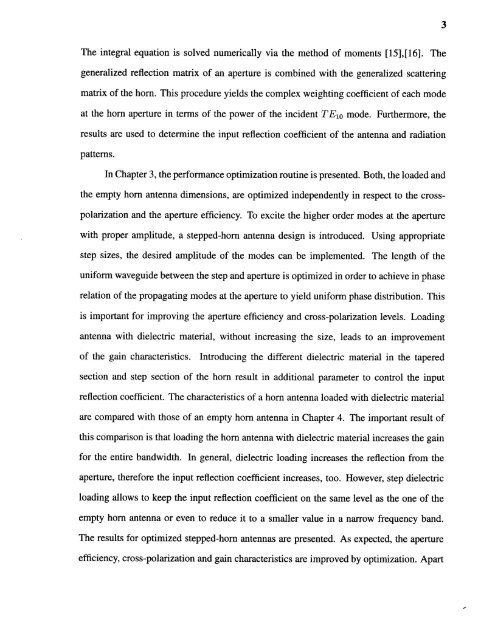Variable permittivity dielectric material loaded stepped-horn antenna
Variable permittivity dielectric material loaded stepped-horn antenna
Variable permittivity dielectric material loaded stepped-horn antenna
You also want an ePaper? Increase the reach of your titles
YUMPU automatically turns print PDFs into web optimized ePapers that Google loves.
3The integral equation is solved numerically via the method of moments [15],[16]. Thegeneralized reflection matrix of an aperture is combined with the generalized scatteringmatrix of the <strong>horn</strong>. This procedure yields the complex weighting coefficient of each modeat the <strong>horn</strong> aperture in terms of the power of the incident TE 10 mode. Furthermore, theresults are used to determine the input reflection coefficient of the <strong>antenna</strong> and radiationpatterns.In Chapter 3, the performance optimization routine is presented. Both, the <strong>loaded</strong> andthe empty <strong>horn</strong> <strong>antenna</strong> dimensions, are optimized independently in respect to the crosspolarizationand the aperture efficiency. To excite the higher order modes at the aperturewith proper amplitude, a <strong>stepped</strong>-<strong>horn</strong> <strong>antenna</strong> design is introduced. Using appropriatestep sizes, the desired amplitude of the modes can be implemented. The length of theuniform waveguide between the step and aperture is optimized in order to achieve in phaserelation of the propagating modes at the aperture to yield uniform phase distribution. Thisis important for improving the aperture efficiency and cross-polarization levels. Loading<strong>antenna</strong> with <strong>dielectric</strong> <strong>material</strong>, without increasing the size, leads to an improvementof the gain characteristics. Introducing the different <strong>dielectric</strong> <strong>material</strong> in the taperedsection and step section of the <strong>horn</strong> result in additional parameter to control the inputreflection coefficient. The characteristics of a <strong>horn</strong> <strong>antenna</strong> <strong>loaded</strong> with <strong>dielectric</strong> <strong>material</strong>are compared with those of an empty <strong>horn</strong> <strong>antenna</strong> in Chapter 4. The important result ofthis comparison is that loading the <strong>horn</strong> <strong>antenna</strong> with <strong>dielectric</strong> <strong>material</strong> increases the gainfor the entire bandwidth. In general, <strong>dielectric</strong> loading increases the reflection from theaperture, therefore the input reflection coefficient increases, too. However, step <strong>dielectric</strong>loading allows to keep the input reflection coefficient on the same level as the one of theempty <strong>horn</strong> <strong>antenna</strong> or even to reduce it to a smaller value in a narrow frequency band.The results for optimized <strong>stepped</strong>-<strong>horn</strong> <strong>antenna</strong>s are presented. As expected, the apertureefficiency, cross-polarization and gain characteristics are improved by optimization. Apart
















